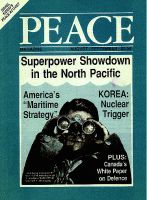
Peace Magazine Aug-Sep 1987, page 31. Some rights reserved.
Search for other articles by Robert Light here
Canada is nuclear weapons-free and that's the way it's going to stay!
- Brian Mulroney in a 1984 election promise
EVEN though the vast majority of Canadians want a verifiable nuclear weapons freeze between the superpowers, our federal government continues to welcome the visits of nuclear-capable warships with open arms: no questions asked. Since 1984, when the New Zealand government banned the visits of nuclear-capable warships, our country has seen a 150 per-cent increase in the number of visits from the nuclear navies of France, England, and the USA. These nations are concerned that Canada may develop the "nuclear allergy" too.
The nuclear navies try to keep their fleets dispersed in foreign ports. This enhances their ability to survive a sudden pre-emptive nuclear attack on the their own territory. They can then release a massive retaliation against their enemy. (A Trident missile can be launched from Halifax Harbor, to hit the Kremlin in only a half hour.)
Canadians face the danger of accidents from these warships. The U.S. Navy, which is the best equipped and trained in the world, admits to having over 600 nuclear accidents in the past 22 years. Just one detonated nuclear attack submarine could devastate a port city with the power of five thousand 1917 Halifax explosions. A nuclear powered warship is a floating Chernobyl disaster looking for a place to happen. A core meltdown would explode once it bored through the hull and reached water. The explosion would rip the warship into deadly shrapnel and the plutonium-steam plume could irradiate an area with a twenty-eight mile radius. Cities the size of Vancouver and Halifax would have to be totally evacuated within three hours!
In response to this threat to our security and safety, some
peace activists in Nanoose Bay, Victoria, and Vancouver began, in 1985, to hold public talks and land protests on the issue. By 1986, each community began to organize nonviolent boat protests to stop the warships. In Vancouver there were no less than twelve harbor actions in a four month period against thirty six naval vessels.
The strategy of the boat protesters is to focus greater media attention on the issue. This should lead to increased public pressure for more municipal and provincial Nuclear Weapons Free Zones. Finally, this must lead to a similar policy on a national scale. This is how it happened in New Zealand. It can happen here too. All the peace groups involved are committed to a long struggle despite the obstacles ahead. Halifax saw its first boat protest on May 21 when a small contingent of boaters went out to protest an incoming French guided missile frigate, the "Commandante Bourdais," and a U.S. nuclear attack submarine. Peace activists in Ontario are now preparing a boat and land protest when the U.S. Frigate "Oliver Hazard Perry" arrives in Toronto on August 22. The boat protest group, "Save Our Seas -- Vancouver" has already done two protests this year and there are more submarines expected in Nanoose Bay soon.
It took over a decade of protesting to stop the warships from entering the ports of New Zealand. Canada may take longer to achieve the same goal, but we have a great need to accomplish such a feat. We are situated between the U.S. and USSR. If they go to war it will be in our own backyard
The nuclear warship visits may soon become a major focus of the Canadian peace movement. It may become as important as the cruise missile testing issue was in the early part of this decade. However, the chances of success are greater because of the obvious threat these warships pose. It is important to note that Iceland, a fellow NATO member, banned nuclear-capable warships two years ago.
Robert Light lives in Vancouver and is involved in flotilla actions there and around the country.

Peace Magazine Aug-Sep 1987, page 31. Some rights reserved.
Search for other articles by Robert Light here